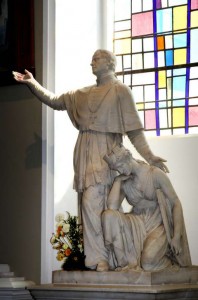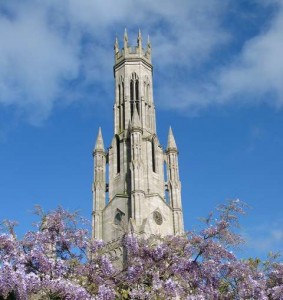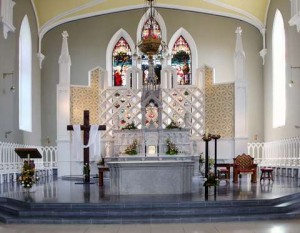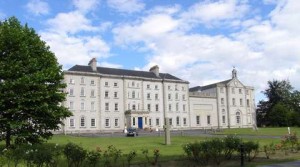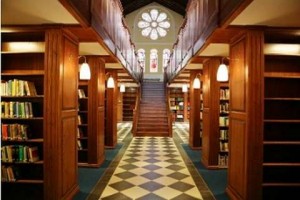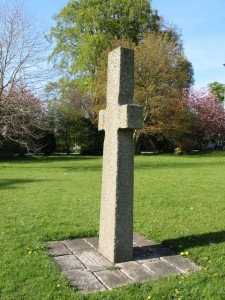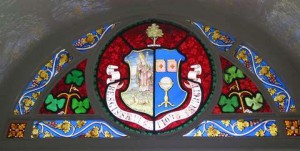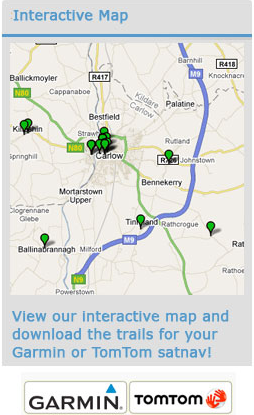Sites
About the Project
There are a number of significant ecclesiastical sites in Co. Carlow, perhaps the most important being the Cathedral of Saint Laserian in Old Leighlin and the monastic settlements at St. Mullins, Clonmore and Killeshin. These sites have fascinating histories and contain important architectural and ecclesiastical remains.
Source: CHL Tourism Development Strategy for Co. Carlow 2000 – 2006 pp. 19
In Summer 2008 Carlow County Manager, Mr. Tom Barry, along with a number of interested individuals and agencies formed a Tourism Strategic Planning Group with a view to exploring the potential of heritage and cultural tourism for the county of Carlow. Following deliberation, it was agreed that the group should firstly seek to investigate the potential of developing and marketing an ecclesiastical trail of County Carlow bearing in mind the relevant expertise available within the group structure and the richness and variety of sites available within the county.
It was agreed, that at the time, the ecclesiastical product in Co. Carlow was neither fully appreciated nor developed to its maximum potential. There are a number of sites of considerable interest, which if appropriately interpreted could act as a tool for leveraging further appreciation of this valuable heritage resource and in turn improve visitor numbers and economic benefits for the county.
In the 5th and 6th centuries, Carlow became an important early Christian centre. Throughout the county monastic settlements were founded including the internationally renowned site at Old Leighlin. In 630 A.D. in St. Laserian’s Cathedral, Old Leighlin a significant church synod was held which determined the date for the ceremony of Easter worldwide, the formula is still in use to this day. The village of St. Mullins, where St. Moling’s 7th century monastic settlement was founded is one of Carlow’s finest ecclesiastical sites and the remains of a 10th century round tower may still be viewed there. Other sites of interest include the collection of early Christian antiquities at Clonmore, the site of the former Convent at Aghade Church which was established by Dermot McMurrough, King of Leinster as a sub-abbey of St. Mary de Hoggis in Dublin and the 5th century Romanesque Doorway at Killeshin which is considered the finest in the country.
Many important early religious leaders were either born in County Carlow or received their formal training here before establishing significant religious settlements across Europe including St. Columbanus, the precursor of Irish European Missionaries, who was born in Myshall in c. 540 A.D. St. Willibrord completed his studies at Killogan, Co. Carlow and from here embarked on a mission to the Low Countries where he is still celebrated and revered as the national saint of Luxembourg.
In the 18th, 19th and early 20th centuries Carlow continued to develop its ecclesiastical profile with the establishment of Carlow College, Ireland’s oldest Catholic third level institution, Carlow Cathedral and the foundation of the Patrician and Brigidine orders which were to develop into a worldwide network over time. The Adelaide Memorial Church, Myshall was built as a miniature of Salisbury Cathedral in 1912 by John Duguid of Dover, to commemorate his wife Adelaide who died in 1903 and daughter Constance who was killed in a riding accident near the village. Lorum Church of Ireland Church is a particularly fine 18th century granite church with earlier church ruins immediately adjacent. In close proximity to the site is Lorum High Cross and two Holy Wells connected to St. Molaoise (St. Mullins) and St. Laserian (Old Leighlin).
Leighlinbridge is the birthplace of Cardinal Patrick Moran, Australia’s first Cardinal. Clonmelsh Cemetery, located nearby features the gravestones of Walt Disney’s ancestors and a Butler family vault, Carlow man Pierce Butler was a signatory of the American Constitution. In the grounds of Saint Mary’s Catholic Church, Bennekerry is the burial place of Frank O’ Meara, the famous impressionist artist (1853-1888) which features a particularly attractive tomb, designed in a style similar to the medieval Killeshin doorway. The town of Tullow holds a strong connection with Fr. Murphy of 1798 fame and there is a dedicated trail to the aforementioned priest in the Tullow area, while, what are reported to be his last vestments may be viewed in Tullow Museum in the town centre.
Membership of Tourism Strategic Planning Group
Membership of the Tourism Strategic Planning Group reflects key experts and agencies in the county who have an important role to play in the future presentation and development of Carlow’s ecclesiastical heritage offering. Current membership includes:
| Name | Representative Organisation |
| Mr. Tom Barry | arlow County Manager & Chairperson Tourism Strategic Planning Group |
| Sr. Declan de Paor | Historian and author of St. Moling Luachra |
| Mr. Gerry Moloney | Lecturer – Carlow I.T. |
| Mr. Dermot Mulligan | Curator – Carlow County Museum |
| Mr. Tom McGrath | Registrar – Carlow College & Editor Carlow History & Society |
| Mr. Martin Nevin | Historian & former Editor of Carloviana, former President of the Carlow Historical & Archaeological Society |
| Ms. Bernie O’ Brien | Director of Services – Community & Enterprise, Economic Development &
Corporate, Carlow County Council |
| Monsignor Kevin O’ Neill | President – Carlow College |
| Ms. Eileen O’ Rourke | C.E.O., Carlow Tourism |
| Ms. Mary Walsh | Manager – Carlow County Development Partnership Ltd. |
| Reverend Gordon Wynne | Dean St. Laserian’s Cathedral, Old Leighlin (since retired) |
To date the work of the group has included:
- compilation of a comprehensive list of 51 ecclesiastical sites and religious attractions within the county which may have the potential to form part of an ecclesiastical trail.
- completion of a resource audit in respect of each of those sites based upon the following criteria:
a) access including disabled access
b) visitor services on site including public facilities, parking, brochure/information material and tour guides
c) opening season and admission rate if applicable
d) details of recorded monuments/protected structures
e) identification of site ownership and management
- Compilation of a high-quality print publication “Carlow – Trails of the Saints” which can be downloaded from this site.
- Development of a dedicated website – http://trails.carlowtourism.com
The completion of this audit identified that Carlow has a strong ecclesiastical product which could be developed and marketed to form an ecclesiastical trail. Three routes were established which feature on this website.
Route 1: North Carlow - St. Patrick’s Trail
Route 2: Middle Carlow – St. Lazerian’s Trail
Route 3: South Carlow – St. Moling’s Trail
In developing this ecclesiastical trail the committee wished to link with the existing strong community involvement at many of the sites. For years a large number of the sites have been maintained by local committees because they appreciate their importance and a number of the sites still have annual services taking place such as pattern days and graveyard masses. The communities are supported in their endeavours by Carlow Local Authorities with a specific grant aid scheme. In accordance with the County Carlow Heritage Plan an annual training day based around the care and conservation of graveyards is coordinated through Carlow County Museum to actively encourage groups to continue to adhere to best principles.
Objectives of the Carlow Ecclesiastical Heritage Trail
The objectives of the initiative are as follows:
- To ensure survival of a valuable heritage resource within Co. Carlow.
- To generate enhanced awareness of the ecclesiastical heritage product both amongst the people of Carlow, a key target audience for all activities and by visitors to the area.
- To analyse and identify sites with the best potential to create a memorable ecclesiastical trail.
- To position Carlow as an area of significance for ecclesiastical heritage in the context of the South East region and of Ireland.
- To add a further significant dimension to the range of heritage attractions available within the county.
- To create a unique trail that will have wide appeal within the heritage market and offer a stimulating and memorable experience to visitors, strongly themed around the concept of ecclesiastical heritage.
- To stimulate increased tourism flows in and around the rural and urban areas of Co. Carlow.
- Many of the ecclesiastical sites have a spiritual atmosphere of peace, reconciliation and relaxation. In developing this trail it is an objective of the Tourism Strategic Planning Group that the character of these special places is preserved in its truest form.
- Heritage has a key role to play in delivering on the national architectural and archaeological agenda. In this regard this project seeks to further the key principles of architectural and archaeological preservation.
- It is important to note that the objective of the Tourism Strategic Planning Group and the Carlow Ecclesiastical Heritage Trail does not involve the delivery of economic performance through ecclesiastical tourism at all costs, nor is it intended to realise short term tourism gains at the expense of Carlow’s rich ecclesiastical heritage. Rather its objective is about building recognition through the synergies which exist between tourism and heritage. These synergies will provide a suitable platform for the development of a sustainable, authentic, high quality ecclesiastical heritage trail which benefits local, domestic and overseas visitors.
Carlow Cathedral
Carlow – Ceatharlach
Carlow Town, the county capital is strategically positioned at the meeting point of the Rivers Barrow and Burrin. This trail enjoys a strong association with St. Patrick, Ireland’s national saint. Relax and enjoy discovering its rich Christian heritage in settings which radiate peace and spirituality.
1. Carlow Cathedral was built between 1828-33 to replace a parish chapel which had become too small for the growing population of the town. It was among the first Catholic cathedrals consecrated following the act granting Catholic Emancipation ![]() in 1829.
in 1829.
The cathedral was built by Bishop James Doyle (known as JKL) and financed through public subscription. Bishop Doyle, viewed by many historians as the outstanding bishop of the nineteenth century, was a church reformer, a prolific political writer on the state of Ireland and a prominent social activist. He was renowned for his evidence on Catholic Emancipation ![]() delivered before British Parliamentary committees. His impressive marble memorial statue, carved by the Irish sculptor John Hogan in Rome, represents the bishop with one arm aloft and the other resting on the shoulder of a figure symbolising Ireland, kneeling by his side in an attitude of hope.
delivered before British Parliamentary committees. His impressive marble memorial statue, carved by the Irish sculptor John Hogan in Rome, represents the bishop with one arm aloft and the other resting on the shoulder of a figure symbolising Ireland, kneeling by his side in an attitude of hope.
The cathedral’s architect was Thomas Cobden and it is generally regarded as his most outstanding church building. The granite, neo-Gothic ![]() exterior features a graceful entrance tower which rises some 46 metres and may have been modelled on the Cloth Hall in Bruges, Belgium and medieval towers in England.
exterior features a graceful entrance tower which rises some 46 metres and may have been modelled on the Cloth Hall in Bruges, Belgium and medieval towers in England.
The tower and the façade incorporate some typical Cobden features and decorative flourishes. Before entering the church one should notice the memorial stones marking the burial places of bishops of Kildare and Leighlin.
The interior of the Cathedral was originally very simple with wooden altars and wooden altar rails. The framed-roof was constructed from oak timbers from nearby Oak Park. The original altar rails were removed during renovations in the late nineteenth century and replaced with marble. The most recent refurbishment, which took place in the 1990s, has seen the removal of some of the additions and the reinstatement of Cobden’s original bishop’s throne. The choir stalls also date from Cobden’s time. Among the new features introduced in the 1990s is the baptismal font which is placed right under the central arch of the north transept.
Open: Monday – Friday 7.15 a.m. – 7 p.m., Saturday 9 a.m. – 7.30 p.m. and Sunday 7.45 a.m. – 8 p.m. | Admission: Free
![]() Catholic Emancipation – The repeal of the discriminatory Penal Laws which was completed by 1829.
Catholic Emancipation – The repeal of the discriminatory Penal Laws which was completed by 1829.
![]() Penal Laws – Legislation passed between 1695 and 1728 which severely curtailed the practice of the Catholic religion in Ireland and the participation of Catholics in public life.
Penal Laws – Legislation passed between 1695 and 1728 which severely curtailed the practice of the Catholic religion in Ireland and the participation of Catholics in public life.
![]() Gothic – Style of architecture, originating in the middle ages, characterised by pointed arches. When used in more recent times, it is described as neo-Gothic or Gothic revival.
Gothic – Style of architecture, originating in the middle ages, characterised by pointed arches. When used in more recent times, it is described as neo-Gothic or Gothic revival.
Carlow College
2. Carlow College, otherwise known as St. Patrick’s College is Ireland’s oldest third-level Catholic College. It was founded in 1782 and opened in October 1793 following the relaxation of the Penal laws ![]() which restricted Catholic education. Dr. James Keeffe, Bishop of Kildare and Leighlin along with his successor, Bishop Daniel Delany, were the driving forces behind the foundation of the college. Its aim was to educate boys for the professions and for the priesthood. During the period 1793-2001 over 3,300 students of Carlow College were ordained priests and they have served all over the world. The college has also educated generations of politicians, poets and leaders.
which restricted Catholic education. Dr. James Keeffe, Bishop of Kildare and Leighlin along with his successor, Bishop Daniel Delany, were the driving forces behind the foundation of the college. Its aim was to educate boys for the professions and for the priesthood. During the period 1793-2001 over 3,300 students of Carlow College were ordained priests and they have served all over the world. The college has also educated generations of politicians, poets and leaders.
The earliest part of the building is the large central block which is nearly 37 metres long. An extension was soon needed and a new building plan was initiated in 1817 with Thomas Cobden as architect. The south wing (to the right when facing the college) was added in 1819 and was connected to the existing college by a two-storey link building.
The main north wing was built between 1821 and 1835 on a much grander scale. The front façade is very different from the original building but the use of circular headed windows creates a sense of unity. It contains a very fine cantilevered granite staircase leading up from a granite paved entrance hall. A large hall with semi-circular apse, once the college chapel, is now named the Cobden Hall and is used for College and public events.
The chapel of the Sacred Heart in the Hiberno-Romanesque ![]() style is particularly interesting. It was erected to mark the centenary of the college and now functions as the College Library. An exhibition relating to the history of the college can be seen in the corridor leading into the Library.
style is particularly interesting. It was erected to mark the centenary of the college and now functions as the College Library. An exhibition relating to the history of the college can be seen in the corridor leading into the Library.
In 1832 the college entrance gate and gate lodge were built, almost certainly by Cobden. The lodge is a small two-roomed building with a doorway under a classical pediment and flanked by two Greek Doric columns.
To mark the bicentenary of the opening of the college an exact replica of the plain un-inscribed high cross from nearby Sleaty was erected in the grounds. Immediately opposite is a modern work entitled Sun Stone. This is by the German artist Paul Scheidner and it is aligned with the sun at the summer solstice.
DID YOU KNOW
Lecture rooms in the college are named after famous alumni. The John England Room is named after the first bishop of Charleston, USA (1820-42), while the Therry Room commemorates a pioneer of the Australian Church. Famous lay alumni include James Fintan Lalor, the agrarian agitator and social activist, the Fenian John O’Leary and Frank O’Meara, the impressionist painter.
Open: Daily. Entry into the College buildings is restricted at certain times. Visitors should report to the receptionist at the main entrance.
Admission: Free www.carlowcollege.ie
![]() Penal Laws – Legislation passed between 1695 and 1728 which severely curtailed the practice of the Catholic religion in Ireland and the participation of Catholics in public life.
Penal Laws – Legislation passed between 1695 and 1728 which severely curtailed the practice of the Catholic religion in Ireland and the participation of Catholics in public life.
![]() Romanesque – Style of early medieval architecture characterised by round arches. Sometimes called “Norman”.
Romanesque – Style of early medieval architecture characterised by round arches. Sometimes called “Norman”.
Church of Ireland church
Church of Ireland church
Catholic Church of the Holy Rosary
Catholic Church of the Holy Rosary
